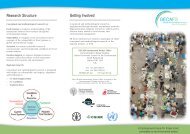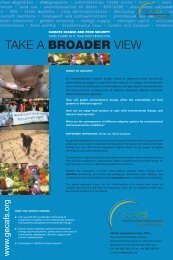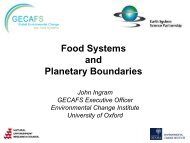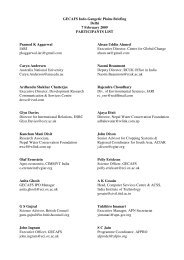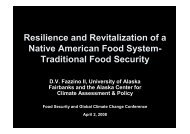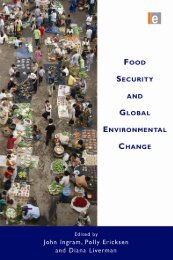These advances have resulted from a fortui<strong>to</strong>us combination of fac<strong>to</strong>rs including scientificadvances in irrigation practices, fertiliser formulation and application technologies, weedcontrol including herbicides, disease and pathogen control using pesticides, andimprovements in crop phenotype from breeding especially the widespread adoption of semidwarfinggenes in cereals (Evans, 1998). <strong>Global</strong>ly, these advances have increased averageglobal cereal productivity (yield per unit area) from 1.2 Mg ha —1 in 1951 <strong>to</strong> about 3.4 Mg ha —1currently with projected increases <strong>to</strong> 4.2 Mg ha —1 by 2020 (Dyson, 1996). This increasedproduction per unit area, coupled with small increases in the area cropped, hascompensated for the decrease in cropped area per caput (Figure 3).However, while crop yields have increased throughout North America, Europe, Australia andAsia, this has not occurred in much of Africa. For example, Sanchez et al. (1997) show thatper capita food production in Africa decreased by about 5–10% between 1980 and 1995,and FAO data analysed by Greenland et al. (1998) demonstrate significant decreases in cropyields in several African countries; the number of countries in Southern Africa classifiedas ‘food surplus’ has actually declined over the last decade (Drimie et al., 2011). The reasons forthe comparatively poor performance of African agriculture are many and complexbut include social instability, poor governance, weathered soils deficient in nutrients, andclimatic variability making reliable irrigation problematic. Greenland et al. (1998) concluded thatin many parts of Africa the yield decreases were a consequence of declining soil fertility—aprocess that could be reversed with inputs of fertilisers if money were available <strong>to</strong> purchaseinputs. It is noteworthy that globally about 40% of crop production comes from the 25% ofland that is irrigated. Restricted or irregular water supply is a major fac<strong>to</strong>r constrainingcrop productivity and this is evident in many data sets. Figure 2, for example, shows yieldsrising more slowly in the Mediterranean countries compared with those in northern Europedue <strong>to</strong> less favourable agroecological conditions related <strong>to</strong> less rainfall (but also highertemperatures leading <strong>to</strong> shortened growing period). Similarly, yields of wheat (grown mainlyin rainfed conditions) in the USA (data given above) have increased more slowly than those ofmaize and rice which are often irrigated.Figure 3 World cereal yield and area harvested per capita. Based on Dyson (1996) and updatedfrom FAOSTAT-Agriculture (2006).26
Given the past success in increasing crop productivity globally, why should we be worried byclimate change? The answer is found in outputs from the last two decades or so of increasingresearch effort by crop scientists and agronomists worldwide on the impacts of climate change onthe world’s major crops. Much of this work has been reviewed and summarised by the IPCCin its Assessment Reports and by others (e.g. Fischer et al., 2001; Fuhrer, 2003; Rosegrantand Cline, 2003; Parry et al., 2004), and shows the largely negative impacts that increasedtemperature will have on crop productivity. The major emphasis of this research has been onthe impacts on crop yield and there is clear crop physiological and agronomic evidence thatclimate change will significantly reduce productivity. For instance, Gregory et al. (1999)summarized experimental findings on wheat and rice that indicated decreased crop duration(and hence yield) of wheat as a consequence of warming and reductions in yields of rice ofabout 5% for each degree rise above 32 °C. These effects of temperature wereconsidered sufficiently detrimental that they would largely offset any increase in yield as aconsequence of increased atmospheric CO 2 concentration [CO 2 ]. Impacts on maize, another ofthe world’s most important crops, has also received considerable attention (e.g. Jones andThorn<strong>to</strong>n, 2003; Stige et al., 2006), suggesting reduced maize production if the global climatechanges <strong>to</strong>ward more El Niño-like conditions, as most climate models predict. This will haveconsequences for farm incomes: a recent pan-African study of climate change impact onAfrican agriculture (Kurukulasuriya et al., 2006) concluded that net farm incomes ofAfrican farmers are highly vulnerable <strong>to</strong> climate with estimated elasticity of response <strong>to</strong>a unit degree increase in temperature ranging from -1.9 for dryland crops <strong>to</strong> -0.5 forirrigated crops. Other studies (e.g. Kettlewell et al., 1999; Slingo et al., 2005) haveinvestigated the effects of climate variability on wheat protein content and other key aspectsof crop quality.Adaptation <strong>to</strong> climate changeThe results on the impacts of climate change on crop productivity (which has been the mainemphasis of climate change/food security research in recent years) indicate the first major rolefor crop scientists and agronomists: the need <strong>to</strong> contribute, with other scientists and farmers,<strong>to</strong> the development of new cropping systems which are resilient <strong>to</strong> changed climate conditions– and better still – more productive (Figure 1). This is because it is clear that climate changewill affect productivity of current cultivars and cropping methods. This will in turn bothcomplicate matters for those currently suffering food insecurity and also frustrate attempts<strong>to</strong> increase crop production in response <strong>to</strong> growing demand over coming decades.Until recently most assessments of the impacts of climate change have been made assuming nomodification <strong>to</strong> crop production practices. It is highly probable, though, that the changes ofclimate and [CO 2 ] will occur sufficiently slowly that changes <strong>to</strong> sowing date, cultivar, cropand other management practices will allow at least some adaptation of the production systemby farmers. Several adaptations are conceivable in the timescale available including:27
- Page 1 and 2: From Food Production to Food Securi
- Page 3 and 4: From Food Production to Food Securi
- Page 5 and 6: Table of ContentsAbstract .........
- Page 7 and 8: Paper 6: Undertaking Research at th
- Page 9: AbstractFood security is a conditio
- Page 12 and 13: 2010 about 925 million people had t
- Page 14 and 15: water) are used, and reduce negativ
- Page 16 and 17: While the flow of the argument abou
- Page 18 and 19: determine interactions along and be
- Page 20 and 21: Paper 3: A Food Systems Approach to
- Page 23: From Food Production to Food Securi
- Page 26 and 27: concerns and are now issues that mu
- Page 28 and 29: the relationships between GEC and f
- Page 30 and 31: Theme 2 aims to understand how comm
- Page 32 and 33: GEC and the Food System of the Indo
- Page 34 and 35: Paper 2: The role of agronomic rese
- Page 38 and 39: Crop selection to determine mechani
- Page 40 and 41: Agronomic science is central to imp
- Page 42 and 43: Agronomic research in relation to f
- Page 44 and 45: The discussion above identifies a n
- Page 46 and 47: interventions and political inertia
- Page 48 and 49: While research on producing food ha
- Page 50 and 51: Box 1 Food system Activities and fo
- Page 52 and 53: In addition to broadening the debat
- Page 54 and 55: options. Examples already seen rang
- Page 56 and 57: Figure 3 Outcomes for 10 variables
- Page 58 and 59: Figure 4 Nine ‘planetary boundari
- Page 60 and 61: Figure 5 Environmental change, food
- Page 62 and 63: Table 1: Indicative analysis of the
- Page 65: From Food Production to Food Securi
- Page 68 and 69: Trade Agreement (NAFTA) and the Eur
- Page 70 and 71: Parry et al., 2005). Conducting foo
- Page 72 and 73: is provided in the ESF/COST Forward
- Page 74 and 75: Paper 5: Engaging Stakeholders at t
- Page 76 and 77: into actions (strategies, policies,
- Page 78 and 79: Box 2 Engaging with stakeholders in
- Page 80 and 81: Box 3 Setting the research agenda f
- Page 82 and 83: Third, and of considerable practica
- Page 84 and 85: Figure 2: Organizing and understand
- Page 86 and 87:
organizations made up of numerous n
- Page 88 and 89:
Elements of good practice in stakeh
- Page 90 and 91:
Finally, it is worth noting that fo
- Page 92 and 93:
development (Lee, 1999; Gunderson a
- Page 94 and 95:
Box 7 The GECAFS stakeholder survey
- Page 96 and 97:
‘break down’ what might be a hi
- Page 98 and 99:
Paper 6: Undertaking Research at th
- Page 100 and 101:
agriculture in many parts of the wo
- Page 102 and 103:
gaps. The presence of a strong tech
- Page 104 and 105:
an average of two years to coalesce
- Page 106 and 107:
Institute for Meteorology and Hydro
- Page 108 and 109:
Identifying case study sitesResearc
- Page 110 and 111:
can both benefit from and contribut
- Page 112 and 113:
Box 5 Mapping stakeholder interests
- Page 114 and 115:
Holding planning meetings in locati
- Page 116 and 117:
This reorientation of the debate fr
- Page 118 and 119:
Importance of this type of research
- Page 120 and 121:
Integrating the food system concept
- Page 122 and 123:
awareness of the GEC issues within
- Page 124 and 125:
pollutants were then introduced as
- Page 126 and 127:
communities operating in food syste
- Page 128 and 129:
Improving input-use efficiency acro
- Page 130 and 131:
governance focuses on the range of
- Page 132 and 133:
Developing research agendas in supp
- Page 134 and 135:
The renewed approach to interdiscip
- Page 136 and 137:
BIELAK, A., HOLMES, J., SAVGÅRD, J
- Page 138 and 139:
EAKIN, H. 2010. What is Vulnerable?
- Page 140 and 141:
GODFRAY, H. C. J., BEDDINGTON, J. R
- Page 142 and 143:
INGRAM, J. S. I. & FERNANDES, E. C.
- Page 144 and 145:
LYUTSE, S. 2010. The One Billion To
- Page 146 and 147:
RAYNER, S. & MALONE, E. L. 1998. Hu
- Page 148 and 149:
UNDP 2006. The 2006 Human Developme
- Page 150 and 151:
activities “from plough to plate
- Page 152 and 153:
contribution to the science agenda:
- Page 154 and 155:
urgently needed, and - given the gr
- Page 156 and 157:
GECAFS plannenmakerij stelde vast d
- Page 158 and 159:
ieder hun eigen groep van betrokken
- Page 160 and 161:
het gebied van beheer hebben betrek
- Page 162:
Curriculum VitaeFollowing a BSc in



